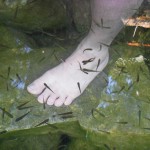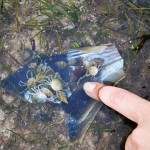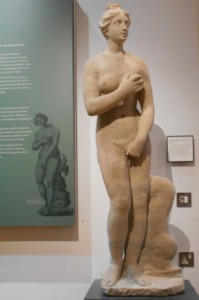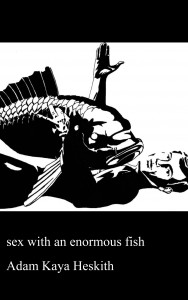In the 2000s, there was a brief craze of unhygienic places having footbaths of water in which you could put your reeking feet in order to have fish nibble at them. This seemed to me like 1. fish abuse, and 2. a good way to catch foot diseases.
When I went to the beautiful Kazdağı National Park in the mountains above the Aegean coast of Turkey, I found that the fish were willing to do this pedicure treatment in the wild. Normally, fish scatter and disappear when you swim in their river. However, just dipping your feet in the river in the picture above would bring a swarm of tiny fish to you. They would chew on your feet if they could get to them. They would also nibble at any part that you put in. A bit off-putting at first, but they never seemed to get hurt by limbs flailing about when I was swimming. Eventually, I just got used to being surrounded by a cloud of orally familiar fish.
There is a place near Sivas in Turkey that claims to use temperature-resistant fish for treating psoriasis. Go for it.
Now, the crabs. The east coast of Yorke Peninsula in South Australia has crystal waters and a high tidal range. If you go for a walk on Sultana Point near Edithburgh at low tide, there is a fascinating array of marine life to see. My 2-year-old daughter and I were eating razorfish (Pinna bicolor). This necessitated cracking open sharp shells and doing a lot of cleaning of stuff inside. After a bit of work, we would get an edible morsel that she would eagerly chew before demanding more. The detritus would attract all sorts of animals, including some small mud crabs.
When the supply of razorfish guts ran out, the crabs would nibble our feet. They were quite insistent with some bits of loose skin but never went as far as causing pain. I don’t know whether the concept of crab pedicures would take off like the fish ones did. There’s a business idea for you.
I suppose these foot-loving creatures would correctly be called pedophiles. Not paedophiles.

Posted February 10, 2014 Posted by Adam in Uncategorized
Shame has a significant role in the creation of many artefacts concerning sex with fish from the classical period.
In this coy Roman nude (veined Marble, 100-130BC, Apulia) in the Ashmolean Museum, we see Venus attempting to cover her nudity after being surprised in the act of sex with a fish. The fish has been represented as a dolphin, probably in deference to the prevailing morality. Dolphins were considered by many Romans, particularly those in the southern provinces, as people who had been chosen by Posiedon for sacred duties.
Consequently, what was commonly known as ‘riding the dolphin’, in which women might take advantage of an aroused captive male dolphin, was not such a source of embarrassment as it may be in modern society. In practice, however, this was rarely done. Dolphins were difficult to keep in captivity and to be responsible for the death of one would draw the wrath of Posiedon. No such consequences were attached to sex with fish, just a certain sniggering stigma. Hence the replacement of the fish in this particular statue: a residual shame still clings to the penitent Venus.
For an immortal, it would be perfectly acceptable to claim that one had, once again, fallen victim to the shape-shifting subterfuges of Jupiter who, as well as adopting the forms of bulls, swans, golden showers and the like, could presumably have his way with an unsuspecting goddess in the form of a fish or a dolphin.

Posted February 3, 2014 Posted by Adam in Uncategorized
In the 2000s, there was a brief craze of unhygienic places having footbaths of water in which you could put your reeking feet in order to have fish nibble at them. This seemed to me like 1, fish abuse and 2. a good way to catch foot diseases.
When I went to the beautiful Kazdağı National Park in the mountains above the Aegean coast of Turkey, I found that the fish were willing to do this pedicure treatment in the wild. Normally, fish scatter and disappear when you swim in their river. However, just dipping your feet in the river in the picture above would bring a swarm of tiny fish to you. They would chew on your feet if they could get to them. They would also nibble at any part that you put in. A bit off-putting at first, but they never seemed to get hurt by limbs flailing about when I was swimming. Eventually, I just got used to being surrounded by a cloud of orally familiar fish.
There is a place near Sivas in Turkey that claims to use temperature-resistant fish for treating psoriasis. Go for it.
Now, the crabs. The east coast of Yorke Peninsula in South Australia has crystal waters and a high tidal range. If you go for a walk on Sultana Point near Edithburgh at low tide, there is a fascinating array of marine life to see. My 2-year-old daughter and I were eating razorfish (Pinna bicolor). This necessitated cracking open sharp shells and doing a lot of cleaning of stuff inside. After a bit of work, we would get an edible morsel that she would eagerly chew before demanding more. The detritus would attract all sorts of animals, including some small mud crabs.
When the supply of razorfish guts ran out, the crabs would nibble our feet. They were quite insistent with some bits of loose skin but never went as far as causing pain. I don’t know whether the concept of crab pedicures would take off like the fish ones did. There’s a business idea for you.
I suppose these foot-loving creatures would correctly be called pedophiles. Not paedophiles.
Posted December 2, 2013 Posted by Adam in Uncategorized
1 Enormous Fish
Stefan awoke to find that he was having sex with an enormous fish. He had expected something like this.
The fish was manifestly unpleasant. It was cold and its skin had the texture of a corpse. Stefan’s first impulse was to shove it away but a lifetime of conditioning made him cautious.
Sure enough, they were being watched. White-coated operatives looked on, adjusting dials and taking notes. Stefan recognised Dr Malek.
“Keep going, boy. Almost finished,” Dr Malek encouraged. “Welcome back. Hope you had a good course. Just doing a few tests to find out how the human body responds to extraordinary stimuli.”
Stefan started to choke out a protest.
“Don’t talk. Keep going to ejaculation. Make sure you get there or we’ll have to do it all over again.”
Stefan gaped at the fish. Its unblinking eyes bulged with outrage. It was not enjoying this. Perhaps it did not know why it was doing this either. It might be better for both of them if he stopped.
But Stefan was back in the System. He had a job to do. Manfully, he worked at increasing his stroke rate. He wondered why the System had decided that it would be a good idea to make him have sex with a big fish. Dr Malek might tell him afterwards.
He was nearly there now. He closed his eyes and tried to visualise Anya. It occurred to him that the fish couldn’t close its eyes. Did he feel unpleasantly hot and dry to it? Could a fish ever be attracted to him, Stefan Griska?
Ah! Stefan felt the muscular contractions beginning. The fish squeezed him rhythmically. He opened his eyes. The fish’s mouth was opening and closing rapidly. Its gill covers were flapping. He poured warm fluid deep into the fish’s body and the fish itself undulated energetically, eyes bulging from its scaly head.
“Right, you can stop doing that now.” Dr Malek’s authority relieved Stefan of duty. “Go and have a shower. You and you,” he gestured at some men in white coats, “get that fish back into the tank. Don’t forget to take the samples. And you,” he pointed at a stooping old man, “Clean up the mess. This man has to sleep in that bed.”
“What’s going on?” Stefan ventured.
“Welcome back.” Dr Malek disregarded the question. “You’ve got time for a short rest. You’re due in the office at seven o’clock.”
“Yes. Of course.” Stefan snapped into routine. He took his toothbrush from the metal rack and squeezed an economical amount of toothpaste onto it. He headed out to the bathroom at the end of the corridor.

Posted November 11, 2013 Posted by Adam in Uncategorized
The embryo of revolution writhes within the id. Striving for the memory of childhood freedoms, the subconscious awaits the movement that will regain that time when parent figures promised the world. The motherland and the father of the revolution can rekindle that vision of the unfocused paradise where desires are fulfilled and sin remains a discredited rumour.
The ideological basis of the 1917 revolution that made possible the formation of the Soviet Union resulted in only an exalted few gaining access to these freedoms. Freud offered the idea that a society in which leaders are revered while individual identity is suppressed will demand escalating aggression by ruling bodies to repress the dissatisfaction of the resentful majority engendered by this denial of an inborn need. (Freud 1930, chapter 5)
Theodore Seuss Geisel, writing as Dr Seuss a few years after Stalin’s death, provides a key in his frontispiece to this allegorical study of the progress of a nation following its revolution. A tiny, Stalinesque figure stands, radiating disillusion, arms spread in resignation. One winglike arm offering a vision of flight is out of balance with the other, a barely functional worker’s hand. The bristling moustache of the dynamic revolutionary is now a dropping mop. The star of communism masks the umbilical evidence of mortal origin. The attempt to replace god has stalled in a cul-de-sac.
Beneath this forlorn figure is written the recurring mantra of the story:
“From there to here,
from here to there,
funny things
are everywhere.”
The ruined leader shrugs and wonders how those for whom it was all done could have betrayed the revolution. He has failed to understand these funny things, the people.
However, the hope of the revolutionary movement is evident as the fish of the title are introduced. These are multifarious in political hue but united in the confidence of their power. The certainties of dichotomy pervade the adjectives. The initial descriptors emphasise unity (‘One fish…) and communist revolution (‘Red fish…’).
Black fish and blue fish, bruised footsoldiers of the revolution, support each other in the new spirit of shared power. The fervour spreads to those of all ages. Old fish is a bespectacled intellectual. New fish heralds the first generation to be raised in the post-revolutionary world.
However, inequalities appear amongst the revolutionaries. One gains the star, a badge of office and privilege. Another, bursting with glee, has requisitioned an automotive symbol of status. The right to punish follows.
An irresistibly powerful, red fish swats a dismayed yellow individual into a position of submission. The face of righteous satisfaction on the dominant party member contrasts with that of the blue counter-revolutionary as it bends for its punishment. Its expression indicates hope of redemption. Divisions in the people’s revolution have emerged to provide precursors for the injustices that will become the focus of this book.
We now concentrate on the figures of a small girl and boy who personify the revolution. These appear to represent the child at Freud’s phallic stage, in the grip of the so-called pleasure principle. ‘These are not yet conscious of gender differences; they are self-absorbed and ‘not even prospectively … citizen(s) who could be relied upon to do a hard day’s work’. (Eagleton, p134) In short, they are a manifestation of the id. In a previous Seuss novel, ‘The Cat in the Hat’, the superego, represented by a conscientious fish, was in opposition to an id figure, the eponymous Cat. (Seuss 1957) ‘One fish, two fish, red fish, blue fish’ lacks a clear manifestation of the superego, allowing the id to rush joyfully and selfishly through this post-revolutionary playground.
In this first view of the protagonists, the boy and girl move onto the liberated motherland. From their new certainty, they gaze at a representative of the old order, still floundering in the watery mire in which fish first began their struggle for change. Contemptuous of this unevolved anachronism, they prepare to travel away from ‘HERE’. They move off across their new and solid playground to ‘THERE’ in search of those funny things that are everywhere.
They soon find some. Perched atop a pink phallic tree, they observe the enormous power of the masses, yet to be effectively harnessed. These workers ‘run for fun in the hot, hot sun’. (p10) The twin futures of the motherland sit beneath their parasol and plan their means of putting this underutilised source of energy to generation of state revenue.
On page 12, we see a further view of the dehumanised masses. This column of damaged citizens may be returning from one of the wars that characterised the genesis of the union. The prepubescent representatives of the new order speculate dismissively on the origins of these citizens, effectively indicating that the long history of the culture is now irrelevant. The children begin to classify their subject human resources. Some are fast and high, perhaps to be tagged for privilege; others are slow, or indeed low. The industrial proletariat and the rural peasantry are united abbreviatively as ‘pets’, avoiding the difficulties of the Marxist revolution which depended on the mobilisation of industry in an overwhelmingly agricultural society.
One particular society of pets is the ‘Zeds’ (page 54-55), apparently resident in an outlying republic. Blank and manipulable, the Zeds are reliant on another childlike representative of the revolutionary committee who single-handedly lops off their burgeoning protuberances in order to ensure conformity to externally determined standards. The elite are represented by humanity, the masses – the pets – by subhumanity.
Conformity is similarly enforced in the scene on page 34. Only the pet who quietly accepts the full duty of a citizen is permitted the privilege of citizenship. The dissenter will be moved to somewhere unpleasant. The shape of this exile becomes chillingly evident on page 48 where we see a pet, displaying signs of divergence from revolutionary norms, exiled to some Siberian hell. This chastised creature has been rejected by the motherland and is back in that foul water in which the struggle against backwardness began.
In the meantime, the happy manifestations of privileged id are busy innovating. Their experiments in animal husbandry lead to the existence of a cutting-edge form of cow. We see one of the scientific leaders on page 16. He has improved himself to the extent of having an extra finger. “I wish I had eleven, too!” exclaim the protagonists.
This may be a reference by Seuss to Stalin’s favour of the flawed Lamarckian science of Trofim Denisovich Lysenko (Hobsbawm p533). Officially rejecting Darwinian genetics, Stalin supported fruitless attempts by Lysenko to improve agriculture in the Soviet Union by attempting to promote the inheritance of acquired characteristics, an avenue long rejected in the west.
On the following page, the astonishing creatures serve as a reminder of the desirability of orthodoxy. Exercising individuality on the one-humped Wump may be appealing but it is nothing to the joy of being in line with Party ideology, achieved by joining the leader Mr Gump on his incomparable seven-hump Wump. The triumph of subsuming one’s identity in the shared warmth of official approval outshines all other temptations.
However, as privileged members of the Party our children have access to pets as status symbols. We are introduced to the massive Zans, the Gack and the comforting Zeep at the end of the book.
Several political cartoons portray the state of the relationship with the masses. In the first, the boy and girl pedal the machinery of the state while their enormous ‘Mike’ rides on a seat that supports him only if the machine is going downhill, that is if no effort is required to propel it. As soon as the going gets hard, Mike is tipped off and must push the protagonists up the metaphorical hill while they close their eyes and put their feet up. The message is clear: the pets do the hard labour; the intelligentsia do the steering (when they feel like it).
Later another massive figure features in a boxing match with the male central character. The boy is tiny beside the powerful Gox but there is no doubt that he will be allowed to win. This cartoon illustrates the inequalities in the distribution of power. The delicate nature of this balance is emphasised by the precarious balance of a vase on a rickety table. Things could easily go wrong.
The next page warns of the possibility of a further proletarian (or ‘pet’) revolution. The naked boy showers happily in front of yet another hirsute giant, this time a ‘Ying’. The Ying, mindful of the power of his master, slavishly copies every detail of the boy’s posture and action. However the presence of water, that treacherous pre-revolutionary medium, warns of reactionary thoughts. The Ying is armed with a bar of soap, insecurely clutched between thumb and forefinger, and a distinctly erect brush.
The reverse of this pet-owning luxury is shown in infrequent glimpses of the underclass. We meet a Nook who will starve because he cannot read the instructions that would enable him to prepare food. A member of the former aristocracy displays his gold teeth and absurdly outdated pet. His boots and hat are worn out. Failure to join the revolution has left these beings in unfortunate and meaningless lives.
Religion clearly survives in the post-revolutionary world. The enigmatic Ish, his name a suffix that diffuses meaning, is able to feed the masses by means of his swishing fish production. He maintains the ability to nourish his flock, presumably spiritually, despite the need to disguise his religious role in the community.
Another column of pets, sheep this time, walk ‘all night from near to far’. (page 32) These zealots are viewed with horror by the young protagonists, as they walk blissfully away from the guiding star of Communism, once that of Christianity. This may represent the Jews, ridiculed for their faith, and unconventionally mobile in the Soviet Union after Tsarist limits on their movement ceased to exist. Increasing repression after World War II forced further moves on the Jewish population and, although at the time of publication of ‘One fish, two fish, red fish, blue fish’ migration to the recently formed Israel was not yet permitted, many Jews had doubtless begun their spiritual exodus. Small wonder that the watching citizens, seeing the traditional scapegoats approach an alien paradise, wonder who will be the next victims.
They will not have long to wait. In the penultimate scene, they lift the monstrous ‘Clark’ from moist obscurity and invite him into mainstream society. He will grow and grow. The bureaucracy of the Secret Police is now able to penetrate the homes of all citizens. “Will our mother like this?” muse the protagonists. “We don’t know.” (p61) The certainties expressed with polar opposites at the start of the book have lost that focus.
The developing but still infant ego has begun to develop boundaries and perceive a reality outside itself. While most of the entities and events throughout ‘One fish, two fish, red fish, blue fish’ are directly related to the protagonists, the developing recognition of the world of the Zeds, for example, which the nascent state must administer without having any direct experience of the place, suggests that the post-revolutionary entity is developing beyond the pleasure principle.
At times, language proves unequal to the task of explaining what things are and why they happen. We are referred to the authority of unseen parent figures: dad, mother, pop. The id of the revolution is gaining some balance from a cultural super-ego. Freud wrote that the “…super-ego of an epoch of civilisation has an origin similar to that of an individual. It is based on the impression left behind by the personalities of great leaders…” (Freud 1930, par 8.11).
For the children of the revolution, a semblance of conscience arises from the words of the ideological creators of this new world order. Development of the super-ego in any other form is hindered by the lack of reality that imposes upon the lives of the childlike heroes who direct the destiny of this state. The way in which the Party deals with dissidents is not tempered by conscience, either fear of the consequences from society or an internal super-ego. Sacrifices by the masses are needed for the ultimate triumph of the revolution.
The final scene is one of deceptive peace and security. The citizens sleep under the protection of the Party behemoth that they have come to trust. But the warning is stark.
“Today is gone. Today was fun.
Tomorrow is another one.
Every day,
from here to there,
funny things are everywhere.” (p63)
Wrapped in the embrace of their huge, furry pet, the revolutionary leaders sleep. They seem secure, unaware of the incipient political power represented by the great mass of the pet by whom they are supported. The spectre of Clark lurks, ready to drag them back into the murky waters of pre-revolutionary chaos. The betrayal of the motherland is imminent.
Bibliography
Eagleton, T (1988) Literary Theory: an introduction (2nd ed). Blackwell, Malden MA.
Freud, S. (1930) Civilisation and its discontents. Extract at <http://www.mdx.ac.uk/www/study/xfre.htm>
Hobsbawm, E. (1994) Age of Extremes: The Short Twentieth Century Abacus, London.
Minear, Richard H. (1999) Dr. Seuss Goes to War The New Press, New York.
Seuss, Dr. (1957) The Cat in the Hat Beginner Books (Random House), New York.






